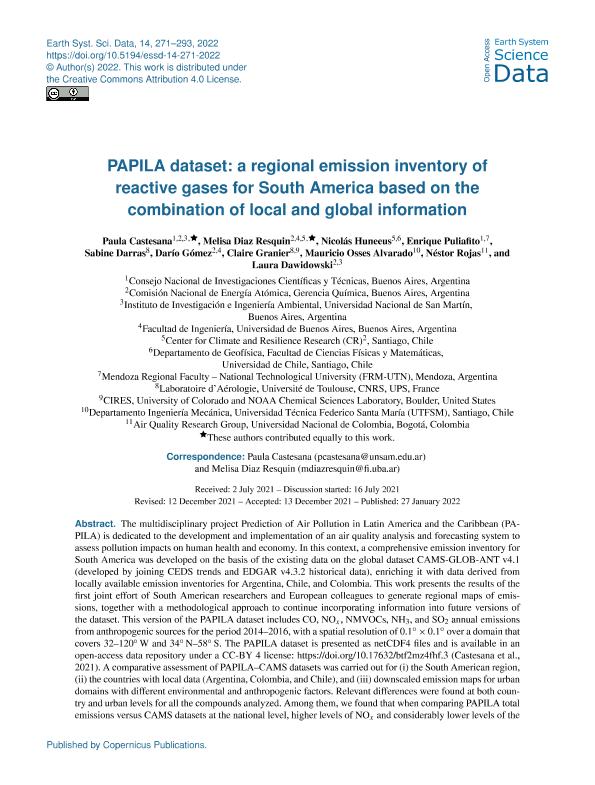Artículo
PAPILA dataset: A regional emission inventory of reactive gases for South America based on the combination of local and global information
Castesana, Paula Soledad ; Diaz Resquin, Melisa; Huneeus, Nicolás; Puliafito, Salvador Enrique
; Diaz Resquin, Melisa; Huneeus, Nicolás; Puliafito, Salvador Enrique ; Darras, Sabine; Gómez, Darío; Granier, Claire; Osses Alvarado, Mauricio; Rojas, Néstor; Dawidowski, Laura Elena
; Darras, Sabine; Gómez, Darío; Granier, Claire; Osses Alvarado, Mauricio; Rojas, Néstor; Dawidowski, Laura Elena
 ; Diaz Resquin, Melisa; Huneeus, Nicolás; Puliafito, Salvador Enrique
; Diaz Resquin, Melisa; Huneeus, Nicolás; Puliafito, Salvador Enrique ; Darras, Sabine; Gómez, Darío; Granier, Claire; Osses Alvarado, Mauricio; Rojas, Néstor; Dawidowski, Laura Elena
; Darras, Sabine; Gómez, Darío; Granier, Claire; Osses Alvarado, Mauricio; Rojas, Néstor; Dawidowski, Laura Elena
Fecha de publicación:
01/2022
Editorial:
Copernicus Publications
Revista:
Earth System Science Data
ISSN:
1866-3516
Idioma:
Inglés
Tipo de recurso:
Artículo publicado
Clasificación temática:
Resumen
The multidisciplinary project Prediction of Air Pollution in Latin America and the Caribbean (PAPILA) is dedicated to the development and implementation of an air quality analysis and forecasting system to assess pollution impacts on human health and economy. In this context, a comprehensive emission inventory for South America was developed on the basis of the existing data on the global dataset CAMS-GLOB-ANT v4.1 (developed by joining CEDS trends and EDGAR v4.3.2 historical data), enriching it with data derived from locally available emission inventories for Argentina, Chile, and Colombia. This work presents the results of the first joint effort of South American researchers and European colleagues to generate regional maps of emissions, together with a methodological approach to continue incorporating information into future versions of the dataset. This version of the PAPILA dataset includes CO, NOx, NMVOCs, NH3, and SO2 annual emissions from anthropogenic sources for the period 2014-2016, with a spatial resolution of 0.1gg×g0.1gover a domain that covers 32-120ggW and 34ggN-58ggS. The PAPILA dataset is presented as netCDF4 files and is available in an open-Access data repository under a CC-BY 4 license: 10.17632/btf2mz4fhf.3 . A comparative assessment of PAPILA-CAMS datasets was carried out for (i) the South American region, (ii) the countries with local data (Argentina, Colombia, and Chile), and (iii) downscaled emission maps for urban domains with different environmental and anthropogenic factors. Relevant differences were found at both country and urban levels for all the compounds analyzed. Among them, we found that when comparing PAPILA total emissions versus CAMS datasets at the national level, higher levels of NOx and considerably lower levels of the other species were obtained for Argentina, higher levels of SO2 and lower levels of CO and NOx for Colombia, and considerably higher levels of CO, NMVOCs, and SO2 for Chile. These discrepancies are mainly related to the representativeness of local practices in the local emission estimates, to the improvements made in the spatial distribution of the locally estimated emissions, or to both. Both datasets were evaluated against surface concentrations of CO and NOx by using them as input data to the WRF-Chem model for one of the analyzed domains, the metropolitan area of Buenos Aires, for summer and winter of 2015. PAPILA-based modeling results had a smaller bias for CO and NOx concentrations in winter while CAMS-based results for the same period tended to deliver an underestimation of these concentrations. Both inventories exhibited similar performances for CO in summer, while the PAPILA simulation outperformed CAMS for NOx concentrations. These results highlight the importance of refining global inventories with local data to obtain accurate results with high-resolution air quality models.
Palabras clave:
EMISSION INVENTORY
,
SOUTH AMERICA
,
ATMOSPHERE
,
PAPILA
Archivos asociados
Licencia
Identificadores
Colecciones
Articulos(CCT - MENDOZA)
Articulos de CTRO.CIENTIFICO TECNOL.CONICET - MENDOZA
Articulos de CTRO.CIENTIFICO TECNOL.CONICET - MENDOZA
Citación
Castesana, Paula Soledad; Diaz Resquin, Melisa; Huneeus, Nicolás; Puliafito, Salvador Enrique; Darras, Sabine; et al.; PAPILA dataset: A regional emission inventory of reactive gases for South America based on the combination of local and global information; Copernicus Publications; Earth System Science Data; 14; 1; 1-2022; 271-293
Compartir
Altmétricas



